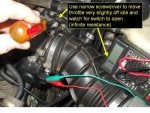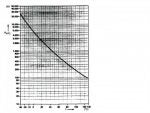After working the idle fault on my "S," I thought it useful to write a comprehensive guide on the subject since it is such a common problem. The factory manuals are pretty skimpy on the subject. Please post a note about anything you see that is not correct or clear and I'll change it. There is a downloadable PDF of this Guide at the bottom of this post.
________________________________
Before we get into a discussion of the possible causes of an idle air problem, it should be said that if the problem is a surging or just straight high idle speed, the problem is most likely a maladjusted Throttle Min/Max Switch. However, given that these cars are getting old now, you should take a few minutes to assess the entire system. Ensure that the ignition system is functioning normally, before blaming anything else.
Understanding the Alfa Romeo164 3.0L Idle System
Idle problems are fairly common faults on US spec 3.0L engines (B/L & S versions), especially as the engine components and wiring get older. To help in diagnosing the problem, it’s important to understand how the system works and the various components that contribute to controlling idle speed/quality.
First of all, at idle, the main throttle valve is fully closed. ALL air for the engine goes through the Idle Stabilizer (IS) (commonly called the Idle Air Control Valve [IACV]). The Idle Stabilizer is mounted on the rear of the plenum and has a wiring connector that goes to the engine ECU (Electronic Control Unit) and an air hose to the rubber connector between the main throttle valve and the Mass Airflow Meter. The Idle Stabilizer is primarily how idle speed is controlled. The ECU also alters the timing to make more immediate/faster regulation of idle speed. The fuel mixture is not necessarily static at closed throttle - it's varies in relation to RPM and engine temp, as well as an initial enrichment factor after starting. If the revs drop too far at idle, the fuel mixture will go quite rich as a form of last-ditch stall saver. At idle it is set slightly lean intentionally (when Min/Max Throttle Switch is closed). However, if there is a false air leak (air that bypasses the Idle Stabilizer), that can cause high/unstable idle as the the ECU and Idle Stabilizer tries to compensate.
False air leaks can be a problem, although the idle system will do a pretty good job of compensating for small leaks. Vacuum connections to the plenum include the fuel pressure regulator, the fuel vapor recovery system/valve, and the brake booster vacuum line on the rear of the plenum. The fuel vapor recovery system is controlled by a valve next to the vacuum tank in the left front wheel well area. It's purpose is the have excess fuel vapor from the fuel tank sucked into the the plenum and burned. The valve should ONLY open when the engine is not at idle. If it opens at idle, there will be a false air leak.
________________________________
Before we get into a discussion of the possible causes of an idle air problem, it should be said that if the problem is a surging or just straight high idle speed, the problem is most likely a maladjusted Throttle Min/Max Switch. However, given that these cars are getting old now, you should take a few minutes to assess the entire system. Ensure that the ignition system is functioning normally, before blaming anything else.
Understanding the Alfa Romeo164 3.0L Idle System
Idle problems are fairly common faults on US spec 3.0L engines (B/L & S versions), especially as the engine components and wiring get older. To help in diagnosing the problem, it’s important to understand how the system works and the various components that contribute to controlling idle speed/quality.
First of all, at idle, the main throttle valve is fully closed. ALL air for the engine goes through the Idle Stabilizer (IS) (commonly called the Idle Air Control Valve [IACV]). The Idle Stabilizer is mounted on the rear of the plenum and has a wiring connector that goes to the engine ECU (Electronic Control Unit) and an air hose to the rubber connector between the main throttle valve and the Mass Airflow Meter. The Idle Stabilizer is primarily how idle speed is controlled. The ECU also alters the timing to make more immediate/faster regulation of idle speed. The fuel mixture is not necessarily static at closed throttle - it's varies in relation to RPM and engine temp, as well as an initial enrichment factor after starting. If the revs drop too far at idle, the fuel mixture will go quite rich as a form of last-ditch stall saver. At idle it is set slightly lean intentionally (when Min/Max Throttle Switch is closed). However, if there is a false air leak (air that bypasses the Idle Stabilizer), that can cause high/unstable idle as the the ECU and Idle Stabilizer tries to compensate.
False air leaks can be a problem, although the idle system will do a pretty good job of compensating for small leaks. Vacuum connections to the plenum include the fuel pressure regulator, the fuel vapor recovery system/valve, and the brake booster vacuum line on the rear of the plenum. The fuel vapor recovery system is controlled by a valve next to the vacuum tank in the left front wheel well area. It's purpose is the have excess fuel vapor from the fuel tank sucked into the the plenum and burned. The valve should ONLY open when the engine is not at idle. If it opens at idle, there will be a false air leak.












